Hacking JavaFX with Groovy, Clojure, Scala, and Visage: Stephen Chin
- 1. Hacking JavaFX with Groovy, Clojure, Scala, and Visage Stephen Chin Java Evangelist, Oracle [email protected] tweet: @steveonjava
- 2. Meet the Presenter Stephen Chin > Java Evangelist, Oracle > Author, Pro JavaFX Platform 2 Family Man > Open Source Hacker l JFXtras l ScalaFX Motorcyclist l Visage > User Group Co-Leader l Silicon Valley JavaFX User Group l Streamed Live!
- 4. JavaFX 2.0 Platform Immersive Application Experience Leverage your Java skills with modern JavaFX APIs > Cross-platform Animation, Video, Charting > Integrate Java, JavaScript, and HTML5 in the same application > New graphics stack takes advantage of hardware acceleration for 2D and 3D applications > Use your favorite IDE: NetBeans, Eclipse, IntelliJ, etc.
- 5. JavaFX is Now Open Source! Part of the OpenJDK Project Controls available now, additional code added incrementally Project Page: > http://openjdk.java.net/projects/openjfx/ 5
- 6. And Will Run on Tablets!* > iPad (iOS) > Linux (Popular Platform for Tablets That Runs Something Similar to Java) *No Release Timeline Announced Yet 6
- 8. Programming Languages > JavaFX 2.0 APIs are now in Java l Pure Java APIs for all of JavaFX l Binding and Sequences exposed as Java APIs l FXML Markup for tooling > Embrace all JVM languages l Groovy, Scala, Clojure, JRuby l Fantom, Mira, Gosu, Jython, etc. > JavaFX Script is no longer supported by Oracle l Existing JavaFX Script based applications will continue to run l Visage is the open-source successor to the JavaFX Script language
- 9. JavaFX in Java > JavaFX API uses an enhanced JavaBeans pattern > Similar in feel to other UI toolkits (Swing, Pivot, etc.) > Uses builder pattern to minimize boilerplate
- 10. Example Application public class HelloStage extends Application { @Override public void start(Stage stage) { stage.setTitle("Hello Stage"); stage.setWidth(600); stage.setHeight(450); Group root = new Group(); Scene scene = new Scene(root); scene.setFill(Color.LIGHTGREEN); stage.setScene(scene); stage.show(); } public static void main(String[] args) { Application.launch(args); } }
- 11. Example Application Using Builders public class HelloStage extends Application { @Override public void start(Stage stage) { stage.setTitle("Hello Stage"); stage.setScene(SceneBuilder.create() .fill(Color.LIGHTGREEN) .width(600) .height(450) .build()); stage.show(); } public static void main(String[] args) { Application.launch(args); } }
- 12. Observable Properties > Supports watching for changes to properties > Implemented via anonymous inner classes > Will take advantage of closures in the future
- 13. Observable Pseudo-Properties final Rectangle rect = new Rectangle(); rect.setX(40); rect.setY(40); rect.setWidth(100); rect.setHeight(200); rect.hoverProperty().addListener(new ChangeListener<Boolean>() { });
- 14. Observable Pseudo-Properties final Rectangle rect = new Rectangle(); rect.setX(40); rect.setY(40); The property we want to watch rect.setWidth(100); rect.setHeight(200); rect.hoverProperty().addListener(new ChangeListener<Boolean>() { });
- 15. Observable Pseudo-Properties final Rectangle rect = new Rectangle(); rect.setX(40); Only one listener used with generics to rect.setY(40); specify the data type rect.setWidth(100); rect.setHeight(200); rect.hoverProperty().addListener(new ChangeListener<Boolean>() { });
- 16. Observable Pseudo-Properties final Rectangle rect = new Rectangle(); rect.setX(40); rect.setY(40); rect.setWidth(100); rect.setHeight(200); rect.hoverProperty().addListener(new ChangeListener<Boolean>() { public void changed(ObservableValue<? extends Boolean> property, Boolean oldValue, Boolean value) { } }); Refers to the Rectangle.hoverProperty()
- 17. Observable Pseudo-Properties final Rectangle rect = new Rectangle(); rect.setX(40); rect.setY(40); rect.setWidth(100); rect.setHeight(200); rect.hoverProperty().addListener(new ChangeListener<Boolean>() { public void changed(ObservableValue<? extends Boolean> property, Boolean oldValue, Boolean value) { rect.setFill(rect.isHover() ? Color.GREEN : Color.RED); } });
- 18. Binding > Unquestionably the biggest JavaFX Script innovation > Supported via a PropertyBinding class > Lazy invocation for high performance > Static construction syntax for simple cases l e.g.: bind(<property>), bindBiDirectional(<property>)
- 19. Sequences in Java > Replaced with an Observable List > Public API is based on JavaFX sequences > Internal code can use lighter collections API > JavaFX 2.0 also has an Observable Map
- 20. Vanishing Circles ! 20
- 21. Vanishing Circles in Java public class VanishingCircles extends Application { public static void main(String[] args) { Application.launch(args); } @Override public void start(Stage primaryStage) { primaryStage.setTitle("Vanishing Circles"); Group root = new Group(); Scene scene = new Scene(root, 800, 600, Color.BLACK); List<Circle> circles = new ArrayList<Circle>(); for (int i = 0; i < 50; i++) { 40 Lines final Circle circle = new Circle(150); circle.setCenterX(Math.random() * 800); circle.setCenterY(Math.random() * 600); circle.setFill(new Color(Math.random(), Math.random(), Math.random(), .2)); 1299 Characters circle.setEffect(new BoxBlur(10, 10, 3)); circle.addEventHandler(MouseEvent.MOUSE_CLICKED, new EventHandler<MouseEvent>() { public void handle(MouseEvent t) { KeyValue collapse = new KeyValue(circle.radiusProperty(), 0); new Timeline(new KeyFrame(Duration.seconds(3), collapse)).play(); } }); circle.setStroke(Color.WHITE); circle.strokeWidthProperty().bind(Bindings.when(circle.hoverProperty()) .then(4) .otherwise(0)); circles.add(circle); } root.getChildren().addAll(circles); primaryStage.setScene(scene); primaryStage.show(); Timeline moveCircles = new Timeline(); for (Circle circle : circles) { KeyValue moveX = new KeyValue(circle.centerXProperty(), Math.random() * 800); KeyValue moveY = new KeyValue(circle.centerYProperty(), Math.random() * 600); moveCircles.getKeyFrames().add(new KeyFrame(Duration.seconds(40), moveX, moveY)); } moveCircles.play(); } } 21
- 22. Application Skeleton public class VanishingCircles extends Application { public static void main(String[] args) { Application.launch(args); } @Override public void start(Stage primaryStage) { primaryStage.setTitle("Vanishing Circles"); Group root = new Group(); Scene scene = new Scene(root, 800, 600, Color.BLACK); [create the circles…] root.getChildren().addAll(circles); primaryStage.setScene(scene); primaryStage.show(); [begin the animation…] } }
- 23. Create the Circles List<Circle> circles = new ArrayList<Circle>(); for (int i = 0; i < 50; i++) { final Circle circle = new Circle(150); circle.setCenterX(Math.random() * 800); circle.setCenterY(Math.random() * 600); circle.setFill(new Color(Math.random(), Math.random(), Math.random(), .2)); circle.setEffect(new BoxBlur(10, 10, 3)); circle.setStroke(Color.WHITE); [setup binding…] [setup event listeners…] circles.add(circle); } 23
- 24. Setup Binding circle.strokeWidthProperty().bind(Bindings .when(circle.hoverProperty()) .then(4) .otherwise(0) ); 24
- 25. Setup Event Listeners circle.addEventHandler(MouseEvent.MOUSE_CLICKED, new EventHandler<MouseEvent>() { public void handle(MouseEvent t) { KeyValue collapse = new KeyValue(circle.radiusProperty(), 0); new Timeline(new KeyFrame(Duration.seconds(3), collapse)).play(); } }); 25
- 26. Begin the Animation Timeline moveCircles = new Timeline(); for (Circle circle : circles) { KeyValue moveX = new KeyValue(circle.centerXProperty(), Math.random() * 800); KeyValue moveY = new KeyValue(circle.centerYProperty(), Math.random() * 600); moveCircles.getKeyFrames().add(new KeyFrame(Duration.seconds(40), moveX, moveY)); } moveCircles.play(); 26
- 28. Features of Groovy > Modern language l Closures l AST Transforms l Strongly typed dynamic language > Tight integration with Java l Very easy to port from Java to Groovy > Declarative syntax with GroovyFX Builders l Familiar to Groovy and JavaFX Script developers
- 29. Java vs. GroovyFX DSL public class VanishingCircles extends Application { GroovyFX.start { primaryStage -‐> def sg = new SceneGraphBuilder() public static void main(String[] args) { def rand = new Random().&nextInt Application.launch(args); def circles = [] } sg.stage(title: 'Vanishing Circles', show: true) { @Override scene(fill: black, width: 800, height: 600) { public void start(Stage primaryStage) { 50.times { primaryStage.setTitle("Vanishing Circles"); circles << circle(centerX: rand(800), centerY: rand(600), radius: 150, stroke: white, Group root = new Group(); strokeWidth: bind('hover', converter: {val -‐> val ? 4 : 0})) { Scene scene = new Scene(root, 800, 600, Color.BLACK); fill rgb(rand(255), rand(255), rand(255), 0.2) List<Circle> circles = new ArrayList<Circle>(); effect boxBlur(width: 10, height: 10, iterations: 3) for (int i = 0; i < 50; i++) { onMouseClicked { e -‐> 40 Lines 29 Lines final Circle circle = new Circle(150); timeline { circle.setCenterX(Math.random() * 800); at(3.s) { change e.source.radiusProperty() to 0 } circle.setCenterY(Math.random() * 600); }.play() circle.setFill(new Color(Math.random(), Math.random(), Math.random(), .2)); } 671 Characters circle.setEffect(new BoxBlur(10, 10, 3)); } 1299 Characters circle.addEventHandler(MouseEvent.MOUSE_CLICKED, new EventHandler<MouseEvent>() { public void handle(MouseEvent t) { KeyValue collapse = new KeyValue(circle.radiusProperty(), 0); new Timeline(new KeyFrame(Duration.seconds(3), collapse)).play(); } } timeline(cycleCount: Timeline.INDEFINITE, autoReverse: true) { } circles.each { circle -‐> }); at (40.s) { circle.setStroke(Color.WHITE); change circle.centerXProperty() to rand(800) circle.strokeWidthProperty().bind(Bindings.when(circle.hoverProperty()) change circle.centerYProperty() to rand(600) .then(4) } .otherwise(0)); } circles.add(circle); }.play() } } root.getChildren().addAll(circles); } primaryStage.setScene(scene); primaryStage.show(); Timeline moveCircles = new Timeline(); for (Circle circle : circles) { KeyValue moveX = new KeyValue(circle.centerXProperty(), Math.random() * 800); KeyValue moveY = new KeyValue(circle.centerYProperty(), Math.random() * 600); moveCircles.getKeyFrames().add(new KeyFrame(Duration.seconds(40), moveX, moveY)); } moveCircles.play(); } } 29
- 30. GroovyFX.start { primaryStage -‐> def sg = new SceneGraphBuilder() def rand = new Random().&nextInt def circles = [] sg.stage(title: 'Vanishing Circles', show: true) { scene(fill: black, width: 800, height: 600) { 50.times { circles << circle(centerX: rand(800), centerY: rand(600), radius: 150, stroke: white, strokeWidth: bind('hover', converter: {val -‐> val ? 4 : 0})) { fill rgb(rand(255), rand(255), rand(255), 0.2) effect boxBlur(width: 10, height: 10, iterations: 3) } } } } } 30
- 31. GroovyFX.start { primaryStage -‐> def sg = new SceneGraphBuilder() def rand = new Random().&nextInt def circles = [] sg.stage(title: 'Vanishing Circles', show: true) { Builder for GroovyFX scene graphs scene(fill: black, width: 800, height: 600) { 50.times { circles << circle(centerX: rand(800), centerY: rand(600), radius: 150, stroke: white, strokeWidth: bind('hover', converter: {val -‐> val ? 4 : 0})) { fill rgb(rand(255), rand(255), rand(255), 0.2) effect boxBlur(width: 10, height: 10, iterations: 3) } } } } } 31
- 32. GroovyFX.start { primaryStage -‐> def sg = new SceneGraphBuilder() def rand = new Random().&nextInt def circles = [] sg.stage(title: 'Vanishing Circles', show: true) { scene(fill: black, width: 800, height: 600) { 50.times { circles << circle(centerX: rand(800), centerY: rand(600), radius: 150, stroke: white, Declarative Stage definition strokeWidth: bind('hover', converter: {val -‐> val ? 4 : 0})) { fill rgb(rand(255), rand(255), rand(255), 0.2) effect boxBlur(width: 10, height: 10, iterations: 3) } } } } } 32
- 33. GroovyFX.start { primaryStage -‐> def sg = new SceneGraphBuilder() def rand = new Random().&nextInt def circles = [] Inline property definitions sg.stage(title: 'Vanishing Circles', show: true) { scene(fill: black, width: 800, height: 600) { 50.times { circles << circle(centerX: rand(800), centerY: rand(600), radius: 150, stroke: white, strokeWidth: bind('hover', converter: {val -‐> val ? 4 : 0})) { fill rgb(rand(255), rand(255), rand(255), 0.2) effect boxBlur(width: 10, height: 10, iterations: 3) } } } } } 33
- 34. GroovyFX.start { primaryStage -‐> def sg = new SceneGraphBuilder() def rand = new Random().&nextInt def circles = [] sg.stage(title: 'Vanishing Circles', show: true) { scene(fill: black, width: 800, height: 600) { Bind to properties 50.times { circles << circle(centerX: rand(800), centerY: rand(600), radius: 150, stroke: white, strokeWidth: bind('hover', converter: {val -‐> val ? 4 : 0})) { fill rgb(rand(255), rand(255), rand(255), 0.2) effect boxBlur(width: 10, height: 10, iterations: 3) } } } } } 34
- 35. GroovyFX.start { primaryStage -‐> def sg = new SceneGraphBuilder() def rand = new Random().&nextInt def circles = [] sg.stage(title: 'Vanishing Circles', show: true) { Creation Via Loop Sequence scene(fill: black, width: 800, height: 600) { 50.times { circles << circle(centerX: rand(800), centerY: rand(600), radius: 150, stroke: white, strokeWidth: bind('hover', converter: {val -‐> val ? 4 : 0})) { fill rgb(rand(255), rand(255), rand(255), 0.2) effect boxBlur(width: 10, height: 10, iterations: 3) } } } } } 35
- 36. Animation in GroovyFX timeline(cycleCount: Timeline.INDEFINITE, autoReverse: true) { circles.each { circle -‐> at (40.s) { change circle.centerXProperty() to rand(800) change circle.centerYProperty() to rand(600) } } }.play() 36
- 37. Animation in GroovyFX timeline(cycleCount: Timeline.INDEFINITE, autoReverse: true) { circles.each { circle -‐> at (40.s) { change circle.centerXProperty() to rand(800) change circle.centerYProperty() to rand(600) } } Easy animation syntax: }.play() at (duration) {keyframes} 37
- 38. Animation in GroovyFX timeline(cycleCount: Timeline.INDEFINITE, autoReverse: true) { circles.each { circle -‐> at (40.s) { change circle.centerXProperty() to rand(800) change circle.centerYProperty() to rand(600) } } }.play() Key frame DSL 38
- 39. Animation in GroovyFX timeline(cycleCount: Timeline.INDEFINITE, autoReverse: true) { circles.each { circle -‐> at (40.s) { change circle.centerXProperty() to rand(800) tween ease_both change circle.centerYProperty() to rand(600) tween linear } } }.play() Optional easing 39
- 40. Event Listeners in GroovyFX > Supported using the built-in Closure syntax > Optional arguments for event objects onMouseClicked { e -‐> timeline { at(3.s) { change e.source.radiusProperty() to 0 } }.play() } 40
- 41. Event Listeners in GroovyFX > Supported using the built-in Closure syntax > Optional arguments for event objects onMouseClicked { MouseEvent e -‐> timeline { at(3.s) { change e.source.radiusProperty() to 0 } }.play() } Compact syntax {body} 41
- 42. Event Listeners in GroovyFX > Supported using the built-in Closure syntax > Optional arguments for event objects Optional event parameter {event -> body} onMouseClicked { MouseEvent e -‐> timeline { at(3.s) { change e.source.radiusProperty() to 0 } }.play() } 42
- 43. But wait, there is more Grooviness… 43
- 44. Properties in Java public class Person {! private StringProperty firstName;! public void setFirstName(String val) { firstNameProperty().set(val); }! public String getFirstName() { return firstNameProperty().get(); }! public StringProperty firstNameProperty() { ! if (firstName == null) ! firstName = new SimpleStringProperty(this, "firstName");! return firstName; ! }! ! private StringProperty lastName;! public void setLastName(String value) { lastNameProperty().set(value); }! public String getLastName() { return lastNameProperty().get(); }! public StringProperty lastNameProperty() { ! if (lastName == null) // etc.! } ! }! 44
- 45. Properties in GroovyFX public class Person {! @FXBindable String firstName; ! @FXBindable String lastName;! }! 45
- 46. Properties in GroovyFX public class Person {! @FXBindable String firstName; ! @FXBindable String lastName = “Smith”;! }! Optional initializers 46
- 47. Properties in GroovyFX public class Person {! @FXBindable String firstName; ! @FXBindable String lastName = “Smith”;! }! ! Get and set values def p = new Person()! def last = p.lastName! p.firstName = “Agent”! ! 47
- 48. Properties in GroovyFX public class Person {! @FXBindable String firstName; ! @FXBindable String lastName = “Smith”;! }! ! def p = new Person()! def last = p.lastName! Access underlying property for p.firstName = “Agent”! binding ! textField(text: bind(p.lastNameProperty()))! ! 48
- 49. Binding in GroovyFX @FXBindable class Time { Integer hours Integer minutes Integer seconds Double hourAngle Double minuteAngle Double secondAngle public Time() { // bind the angle properties to the clock time hourAngleProperty().bind((hoursProperty() * 30.0) + (minutesProperty() * 0.5)) minuteAngleProperty().bind(minutesProperty() * 6.0) secondAngleProperty().bind(secondsProperty() * 6.0) } } 49
- 50. TableView in Java ObservableList<Person> items = ...! TableView<Person> tableView = new TableView<Person>(items);! ! TableColumn<Person,String> firstNameCol = ! new TableColumn<Person,String>("First Name");! ! firstNameCol.setCellValueFactory(! new Callback<CellDataFeatures<Person, String>, ! ObservableValue<String>>() {! public ObservableValue<String> call(CellDataFeatures<Person, String> p) ! {! return p.getValue().firstNameProperty();! }! });! ! tableView.getColumns().add(firstNameCol);! 50
- 51. TableView in GroovyFX def dateFormat = new SimpleDateFormat("yyyy-MM-dd");! ! tableView(items: persons) {! tableColumn(property: "name", text: "Name", prefWidth: 150)! tableColumn(property: "age", text: "Age", prefWidth: 50)! tableColumn(property: "gender", text: "Gender", prefWidth: 150)! tableColumn(property: "dob", text: "Birth", prefWidth: 150, ! type: Date,! converter: { from -> return dateFormat.format(from) })! }! 51
- 52. Layout in Java TextField urlField = new TextField(“http://www.google.com”);! HBox.setHgrow(urlField, Priority.ALWAYS);! ! HBox hbox = new HBox();! hbox.getChildren().add(urlField);! ! WebView webView = new WebView();! VBox.setVgrow(webView, Priority.ALWAYS);! ! VBox vbox = new VBox();! vbox.getChildren().addAll(hbox, webView);! 52
- 53. Layout in GroovyFX sg.stage(title: "GroovyFX WebView Demo", show: true) { scene(fill: groovyblue, width: 1024, height: 800) { vbox { hbox(padding: 10, spacing: 5) { textField(“http://www.yahoo.com”, hgrow: "always") button("Go”) } webView(vgrow: "always") } } } 53
- 54. Layout in GroovyFX 54
- 55. Layout in GroovyFX gridPane(hgap: 5, vgap: 10, padding: 25) {! columnConstraints(minWidth: 50, halignment: "right")! columnConstraints(prefWidth: 250)! label("Send Us Your Feedback", font: "24pt sanserif", ! row: 0, columnSpan: GridPane.REMAINING, halignment: "center",! margin: [0, 0, 10])! ! label("Name: ", row: 1, column: 0)! textField(promptText: "Your name", row: 1, column: 1, hgrow: 'always')! ! label("Email:", row: 2, column: 0)! textField(promptText: "Your email", row: 2, column: 1, hgrow: 'always')! ! label("Message:", row: 3, column: 0, valignment: "baseline")! textArea(row: 3, column: 1, hgrow: "always", vgrow: "always")! ! button("Send Message", row: 4, column: 1, halignment: "right")! }! 55
- 56. Layout in GroovyFX 56
- 57. GroovyFX Supports… 57
- 58. GroovyFX Supports… 58
- 59. JavaFX With Clojure Artwork by Augusto Sellhorn http://sellmic.com/ 59
- 60. A Little About Clojure > Started in 2007 by Rich Hickey > Functional Programming Language > Derived from LISP > Optimized for High Concurrency (def hello (fn [] "Hello world")) (hello) > … and looks nothing like Java! 60
- 61. Clojure Syntax in One Slide Symbols Collections (commas optional) > numbers – 2.178 > Lists > ratios – 355/113 (1, 2, 3, 4, 5) > strings – “clojure”, “rocks” > Vectors > characters – a b c d [1, 2, 3, 4, 5] > symbols – a b c d > Maps > keywords – :alpha :beta {:a 1, :b 2, :c 3, :d 4} > boolean – true, false > Sets > null - nil #{:a :b :c :d :e} (plus macros that are syntactic sugar wrapping the above) 61
- 62. Clojure GUI Example (defn javafxapp [] (let [stage (Stage. "JavaFX Stage") scene (Scene.)] (.setFill scene Color/LIGHTGREEN) (.setWidth stage 600) (.setHeight stage 450) (.setScene stage scene) (.setVisible stage true))) (javafxapp) 62
- 63. Refined Clojure GUI Example (defn javafxapp [] (doto (Stage. "JavaFX Stage") (.setWidth 600) (.setHeight 450) (.setScene (doto (Scene.) (.setFill Color/LIGHTGREEN) (.setContent (list (doto (Rectangle.) (.setX 25) (.setY 40) (.setWidth 100) (.setHeight 50) (.setFill Color/RED)))))) (.setVisible true))) (javafxapp) 63
- 64. Refined Clojure GUI Example (defn javafxapp [] (doto (Stage. "JavaFX Stage") (.setWidth 600) Doto allows nested data (.setHeight 450) (.setScene (doto (Scene.) structures (.setFill Color/LIGHTGREEN) (.setContent (list (doto (Rectangle.) (.setX 25) (.setY 40) (.setWidth 100) (.setHeight 50) (.setFill Color/RED)))))) (.setVisible true))) (javafxapp) 64
- 65. Closures in Clojure > Inner classes can be created using proxy (.addListener hoverProperty (proxy [ChangeListener] [] (handle [p, o, v] (.setFill rect (if (.isHover rect) Color/GREEN Color/RED))))) 65
- 66. Closures in Clojure > Inner classes can be created using proxy Proxy form: (proxy [class] [args] fs+) f => (name [params*] body) (.addListener hoverProperty (proxy [ChangeListener] [] (handle [p, o, v] (.setFill rect (if (.isHover rect) Color/GREEN Color/RED))))) 66
- 67. JavaFX With Scala 67
- 68. What is Scala 2001 2006 • Scala Started • Scala v2.0 2003/2004 2011 • Scala v1.0 • Scala 2.9.2 (latest) > Started in 2001 by Martin Odersky > Compiles to Java bytecodes > Pure object-oriented language > Also a functional programming language 68
- 69. Why Scala? > Shares many language features with JavaFX Script that make GUI programming easier: l Static Type Checking – Catch your errors at compile time l Closures – Wrap behavior and pass it by reference l Declarative – Express the UI by describing what it should look like > Scala also supports Type Safe DSLs! l Implicit Conversions – type safe class extension l Operator Overloading – with standard precedence rules l DelayedInit / @specialized – advanced language features 69
- 70. Java vs. Scala DSL public class VanishingCircles extends Application { object VanishingCircles extends JFXApp { var circles: Seq[Circle] = null public static void main(String[] args) { stage = new Stage { Application.launch(args); title = "Vanishing Circles" } width = 800 height = 600 @Override scene = new Scene { public void start(Stage primaryStage) { fill = BLACK primaryStage.setTitle("Vanishing Circles"); circles = for (i <-‐ 0 until 50) yield new Circle { Group root = new Group(); centerX = random * 800 Scene scene = new Scene(root, 800, 600, Color.BLACK); centerY = random * 600 List<Circle> circles = new ArrayList<Circle>(); radius = 150 for (int i = 0; i < 50; i++) { fill = color(random, random, random, .2) 40 Lines 33 Lines final Circle circle = new Circle(150); effect = new BoxBlur(10, 10, 3) circle.setCenterX(Math.random() * 800); strokeWidth <== when (hover) then 4 otherwise 0 circle.setCenterY(Math.random() * 600); stroke = WHITE circle.setFill(new Color(Math.random(), Math.random(), Math.random(), .2)); onMouseClicked = { circle.setEffect(new BoxBlur(10, 10, 3)); Timeline(at (3 s) {radius -‐> 0}).play() 1299 Characters circle.addEventHandler(MouseEvent.MOUSE_CLICKED, new EventHandler<MouseEvent>() { public void handle(MouseEvent t) { KeyValue collapse = new KeyValue(circle.radiusProperty(), 0); new Timeline(new KeyFrame(Duration.seconds(3), collapse)).play(); } 591 Characters } content = circles } } } }); circle.setStroke(Color.WHITE); new Timeline { circle.strokeWidthProperty().bind(Bindings.when(circle.hoverProperty()) cycleCount = INDEFINITE .then(4) autoReverse = true .otherwise(0)); keyFrames = for (circle <-‐ circles) yield at (40 s) { circles.add(circle); Set( } circle.centerX -‐> random * stage.width, root.getChildren().addAll(circles); circle.centerY -‐> random * stage.height primaryStage.setScene(scene); ) primaryStage.show(); } }.play(); Timeline moveCircles = new Timeline(); } for (Circle circle : circles) { KeyValue moveX = new KeyValue(circle.centerXProperty(), Math.random() * 800); KeyValue moveY = new KeyValue(circle.centerYProperty(), Math.random() * 600); moveCircles.getKeyFrames().add(new KeyFrame(Duration.seconds(40), moveX, moveY)); } moveCircles.play(); } } 70
- 71. object VanishingCircles extends JFXApp { stage = new Stage { title = "Disappearing Circles" width = 800 height = 600 scene = new Scene { fill = BLACK children = for (i <-‐ 0 until 50) yield new Circle { centerX = random * 800 centerY = random * 600 radius = 150 fill = color(random, random, random, 0.2) effect = new BoxBlur(10, 10, 3) } } } } 71
- 72. object VanishingCircles extends JFXApp { stage = new Stage { title = "Disappearing Circles" width = 800 height = 600 for JavaFX applications Base class scene = new Scene { fill = BLACK children = for (i <-‐ 0 until 50) yield new Circle { centerX = random * 800 centerY = random * 600 radius = 150 fill = color(random, random, random, 0.2) effect = new BoxBlur(10, 10, 3) } } } } 72
- 73. object VanishingCircles extends JFXApp { stage = new Stage { title = "Disappearing Circles" width = 800 height = 600 scene = new Scene { Declarative Stage definition fill = BLACK children = for (i <-‐ 0 until 50) yield new Circle { centerX = random * 800 centerY = random * 600 radius = 150 fill = color(random, random, random, 0.2) effect = new BoxBlur(10, 10, 3) } } } } 73
- 74. object VanishingCircles extends JFXApp { stage = new Stage { title = "Disappearing Circles" width = 800 Inline property definitions height = 600 scene = new Scene { fill = BLACK children = for (i <-‐ 0 until 50) yield new Circle { centerX = random * 800 centerY = random * 600 radius = 150 fill = color(random, random, random, 0.2) effect = new BoxBlur(10, 10, 3) } } } } 74
- 75. object VanishingCircles extends JFXApp { stage = new Stage { title = "Disappearing Circles" width = 800 height = 600 Sequence Creation Via Loop scene = new Scene { fill = BLACK children = for (i <-‐ 0 until 50) yield new Circle { centerX = random * 800 centerY = random * 600 radius = 150 fill = color(random, random, random, 0.2) effect = new BoxBlur(10, 10, 3) } } } } 75
- 76. Binding in Scala Infix Addition/Subtraction/Multiplication/Division: height <== rect1.height + rect2.height Aggregate Operators: width <== max(rect1.width, rect2.width, rect3.width) Conditional Expressions: strokeWidth <== when (hover) then 4 otherwise 0 Compound Expressions: text <== when (rect.hover || circle.hover && !disabled) then textField.text + " is enabled" otherwise "disabled" 76
- 77. Animation in Scala val timeline = new Timeline { cycleCount = INDEFINITE autoReverse = true keyFrames = for (circle <-‐ circles) yield at (40 s) { Set( circle.centerX -‐> random * stage.width, circle.centerY -‐> random * stage.height ) } } timeline.play(); 77
- 78. JavaFX Script-like animation Animation in Scala syntax: at (duration) {keyframes} val timeline = new Timeline { cycleCount = INDEFINITE autoReverse = true keyFrames = for (circle <-‐ circles) yield at (40 s) { Set( circle.centerX -‐> random * stage.width, circle.centerY -‐> random * stage.height ) } } timeline.play(); 78
- 79. Animation in Scala val timeline = new Timeline { cycleCount = INDEFINITE autoReverse = true keyFrames = for (circle <-‐ circles) yield at (40 s) { Set( circle.centerX -‐> random * stage.width, circle.centerY -‐> random * stage.height ) } } Operator overloading for animation timeline.play(); syntax 79
- 80. Animation in Scala val timeline = new Timeline { cycleCount = INDEFINITE autoReverse = true keyFrames = for (circle <-‐ circles) yield at (40 s) { Set( circle.centerX -‐> random * stage.width tween EASE_BOTH, circle.centerY -‐> random * stage.height tween EASE_IN ) } } timeline.play(); Optional tween syntax 80
- 81. Event Listeners in Scala > Supported using the built-in Closure syntax > Arguments for event objects > 100% type-safe onMouseClicked = { (e: MouseEvent) => Timeline(at(3 s){radius-‐>0}).play() } 81
- 82. Event Listeners in Scala > Supported using the built-in Closure syntax > Arguments for event objects > 100% type-safe onMouseClicked = { (e: MouseEvent) => Timeline(at(3 s){radius-‐>0}).play() } Compact syntax {body} 82
- 83. Event Listeners in Scala > Supported using the built-in Closure syntax > Arguments for event objects Event parameter > 100% type-safe {(event) => body} onMouseClicked = { (e: MouseEvent) => Timeline(at(3 s){radius-‐>0}).play() } 83
- 84. TableView in ScalaFX def dateFormat = new SimpleDateFormat("yyyy-MM-dd")! new TableView[Speaker](persons) {! columns = Seq(! new TableColumn[Speaker, String] {! text: "Name"! converter = {_.firstName}! } new TableColumn[Speaker, String] {! text: "Age"! converter = {_.age}! }! new TableColumn[Speaker, String] {! text: "Gender"! converter = {_.gender}! }! new TableColumn[Speaker, String] {! text: "Birth"! converter = {dateFormat.format(_.dob)}, ! }! )}! 84
- 85. JavaFX With Visage 85
- 86. About Project Visage > “Visage is a domain specific language (DSL) designed for the express purpose of writing user interfaces.” > Visage project goals: l Compile to JavaFX Java APIs l Evolve the Language (Annotations, Maps, etc.) l Support Other Toolkits > Come join the team! > For more info: http://visage-lang.org/ 86
- 87. Java vs. Visage DSL public class VanishingCircles extends Application { var circles:Circle[]; Stage { public static void main(String[] args) { title: "Vanishing Circles" Application.launch(args); Scene { } width: 800 height: 600 @Override fill: BLACK public void start(Stage primaryStage) { Group { primaryStage.setTitle("Vanishing Circles"); circles = for (i in [1..50]) { Group root = new Group(); def c:Circle = Circle { Scene scene = new Scene(root, 800, 600, Color.BLACK); centerX: random() * 800 List<Circle> circles = new ArrayList<Circle>(); centerY: random() * 600 for (int i = 0; i < 50; i++) { radius: 150 40 Lines 35 Lines final Circle circle = new Circle(150); fill: color(random(), random(), random(), .2) circle.setCenterX(Math.random() * 800); effect: BoxBlur { circle.setCenterY(Math.random() * 600); height: 10 circle.setFill(new Color(Math.random(), Math.random(), Math.random(), .2)); width: 10 circle.setEffect(new BoxBlur(10, 10, 3)); iterations: 3 1299 Characters circle.addEventHandler(MouseEvent.MOUSE_CLICKED, new EventHandler<MouseEvent>() { public void handle(MouseEvent t) { KeyValue collapse = new KeyValue(circle.radiusProperty(), 0); new Timeline(new KeyFrame(Duration.seconds(3), collapse)).play(); 487 Characters } stroke: WHITE strokeWidth: bind if (c.hover) 5 else 0 onMouseClicked: function(e) { } Timeline {at (3s) {c.radius => 0}}.play() }); } circle.setStroke(Color.WHITE); } circle.strokeWidthProperty().bind(Bindings.when(circle.hoverProperty()) } .then(4) } .otherwise(0)); } circles.add(circle); } } root.getChildren().addAll(circles); Timeline { primaryStage.setScene(scene); for (circle in circles) at (40s) { primaryStage.show(); circle.centerX => random() * 800; circle.centerY => random() * 600 Timeline moveCircles = new Timeline(); } for (Circle circle : circles) { }.play() KeyValue moveX = new KeyValue(circle.centerXProperty(), Math.random() * 800); KeyValue moveY = new KeyValue(circle.centerYProperty(), Math.random() * 600); moveCircles.getKeyFrames().add(new KeyFrame(Duration.seconds(40), moveX, moveY)); } moveCircles.play(); } } 87
- 88. How about JavaFX on… Visage Stage { title: "Vanishing Circles" scene: Scene { width: 800 height: 600 fill: BLACK content: Group { circles = for (i in [1..50]) { Circle { centerX: random() * 800 centerY: random() * 600 } } } } } 88
- 89. How about JavaFX on… Visage Stage { title: "Vanishing Circles" scene: Scene { width: 800 height: 600 fill: BLACK content: Group { circles = for (i in [1..50]) { Circle { centerX: random() * 800 centerY: random() * 600 } } } } } 89
- 90. How about JavaFX on… Visage Stage { title: "Vanishing Circles" Scene { width: 800 height: 600 fill: BLACK Group { circles = for (i in [1..50]) { Circle { centerX: random() * 800 centerY: random() * 600 } } } } } 90
- 91. Visage is JavaFX Script++ > Default Parameters > New Literal Syntax For: l Angles – 35deg, 4rad, 1turn l Colors – #DDCCBB, #AA33AA|CC l Lengths – 5px, 2pt, 3in, 4sp > Null-check Dereference l var width = rect.!width > Built-in Bindable Maps (coming soon!) l var fruitMap = ["red" : apple, "yellow" : banana] l var fruit = bind fruitMap["red"] 91
- 92. Visage and JavaFX 2.0 are made for each other… > Enhanced Binding l Retains lazy evaluation properties with additional expressive power > Integrated Collections l Sequences and Maps automatically convert between JavaFX Observable Lists/Maps > Built-in Animation Syntax l Ties into JavaFX animation subsystem l Provides consistent, clean APIs 92
- 93. Other JVM Languages to Try > JRuby l Faithful to Ruby language with the power of the JVM > Gosu l Up and coming language created at GuideWire l Easy to enhance libraries and create DSLs > Mirah l Invented by Charles Nutter l Local Type Inference, Static and Dynamic Typing > Fantom l Created by Brian and Andy Frank l Portable to Java and .NET l Local Type Inference, Static and Dynamic Typing 93
- 94. Conclusion > You can write JavaFX applications in pure Java > JavaFX is also usable in alternate languages > You can get improved support using DSL libraries l GroovyFX l ScalaFX > Or a dedicated UI JVM Language l Visage
- 95. Stephen Chin [email protected] tweet: @steveonjava Thanks to Dean Iverson and Jonathan Giles for help preparing this talk 95









![Example Application
public
class
HelloStage
extends
Application
{
@Override
public
void
start(Stage
stage)
{
stage.setTitle("Hello
Stage");
stage.setWidth(600);
stage.setHeight(450);
Group
root
=
new
Group();
Scene
scene
=
new
Scene(root);
scene.setFill(Color.LIGHTGREEN);
stage.setScene(scene);
stage.show();
}
public
static
void
main(String[]
args)
{
Application.launch(args);
}
}](https://image.slidesharecdn.com/hackingjavafxwithgroovyclojurescalaandvisage-120719084046-phpapp01/85/Hacking-JavaFX-with-Groovy-Clojure-Scala-and-Visage-Stephen-Chin-10-320.jpg)
![Example Application Using Builders
public
class
HelloStage
extends
Application
{
@Override
public
void
start(Stage
stage)
{
stage.setTitle("Hello
Stage");
stage.setScene(SceneBuilder.create()
.fill(Color.LIGHTGREEN)
.width(600)
.height(450)
.build());
stage.show();
}
public
static
void
main(String[]
args)
{
Application.launch(args);
}
}](https://image.slidesharecdn.com/hackingjavafxwithgroovyclojurescalaandvisage-120719084046-phpapp01/85/Hacking-JavaFX-with-Groovy-Clojure-Scala-and-Visage-Stephen-Chin-11-320.jpg)


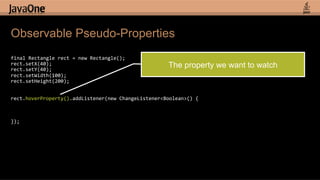




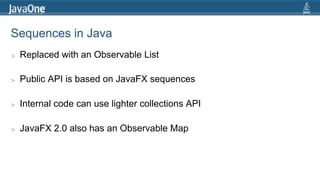

![Vanishing Circles in Java
public
class
VanishingCircles
extends
Application
{
public
static
void
main(String[]
args)
{
Application.launch(args);
}
@Override
public
void
start(Stage
primaryStage)
{
primaryStage.setTitle("Vanishing
Circles");
Group
root
=
new
Group();
Scene
scene
=
new
Scene(root,
800,
600,
Color.BLACK);
List<Circle>
circles
=
new
ArrayList<Circle>();
for
(int
i
=
0;
i
<
50;
i++)
{
40 Lines
final
Circle
circle
=
new
Circle(150);
circle.setCenterX(Math.random()
*
800);
circle.setCenterY(Math.random()
*
600);
circle.setFill(new
Color(Math.random(),
Math.random(),
Math.random(),
.2));
1299 Characters
circle.setEffect(new
BoxBlur(10,
10,
3));
circle.addEventHandler(MouseEvent.MOUSE_CLICKED,
new
EventHandler<MouseEvent>()
{
public
void
handle(MouseEvent
t)
{
KeyValue
collapse
=
new
KeyValue(circle.radiusProperty(),
0);
new
Timeline(new
KeyFrame(Duration.seconds(3),
collapse)).play();
}
});
circle.setStroke(Color.WHITE);
circle.strokeWidthProperty().bind(Bindings.when(circle.hoverProperty())
.then(4)
.otherwise(0));
circles.add(circle);
}
root.getChildren().addAll(circles);
primaryStage.setScene(scene);
primaryStage.show();
Timeline
moveCircles
=
new
Timeline();
for
(Circle
circle
:
circles)
{
KeyValue
moveX
=
new
KeyValue(circle.centerXProperty(),
Math.random()
*
800);
KeyValue
moveY
=
new
KeyValue(circle.centerYProperty(),
Math.random()
*
600);
moveCircles.getKeyFrames().add(new
KeyFrame(Duration.seconds(40),
moveX,
moveY));
}
moveCircles.play();
}
}
21](https://image.slidesharecdn.com/hackingjavafxwithgroovyclojurescalaandvisage-120719084046-phpapp01/85/Hacking-JavaFX-with-Groovy-Clojure-Scala-and-Visage-Stephen-Chin-21-320.jpg)
![Application Skeleton
public
class
VanishingCircles
extends
Application
{
public
static
void
main(String[]
args)
{
Application.launch(args);
}
@Override
public
void
start(Stage
primaryStage)
{
primaryStage.setTitle("Vanishing
Circles");
Group
root
=
new
Group();
Scene
scene
=
new
Scene(root,
800,
600,
Color.BLACK);
[create
the
circles…]
root.getChildren().addAll(circles);
primaryStage.setScene(scene);
primaryStage.show();
[begin
the
animation…]
}
}](https://image.slidesharecdn.com/hackingjavafxwithgroovyclojurescalaandvisage-120719084046-phpapp01/85/Hacking-JavaFX-with-Groovy-Clojure-Scala-and-Visage-Stephen-Chin-22-320.jpg)
![Create the Circles
List<Circle>
circles
=
new
ArrayList<Circle>();
for
(int
i
=
0;
i
<
50;
i++)
{
final
Circle
circle
=
new
Circle(150);
circle.setCenterX(Math.random()
*
800);
circle.setCenterY(Math.random()
*
600);
circle.setFill(new
Color(Math.random(),
Math.random(),
Math.random(),
.2));
circle.setEffect(new
BoxBlur(10,
10,
3));
circle.setStroke(Color.WHITE);
[setup
binding…]
[setup
event
listeners…]
circles.add(circle);
}
23](https://image.slidesharecdn.com/hackingjavafxwithgroovyclojurescalaandvisage-120719084046-phpapp01/85/Hacking-JavaFX-with-Groovy-Clojure-Scala-and-Visage-Stephen-Chin-23-320.jpg)





![Java vs. GroovyFX DSL
public
class
VanishingCircles
extends
Application
{
GroovyFX.start
{
primaryStage
-‐>
def
sg
=
new
SceneGraphBuilder()
public
static
void
main(String[]
args)
{
def
rand
=
new
Random().&nextInt
Application.launch(args);
def
circles
=
[]
}
sg.stage(title:
'Vanishing
Circles',
show:
true)
{
@Override
scene(fill:
black,
width:
800,
height:
600)
{
public
void
start(Stage
primaryStage)
{
50.times
{
primaryStage.setTitle("Vanishing
Circles");
circles
<<
circle(centerX:
rand(800),
centerY:
rand(600),
radius:
150,
stroke:
white,
Group
root
=
new
Group();
strokeWidth:
bind('hover',
converter:
{val
-‐>
val
?
4
:
0}))
{
Scene
scene
=
new
Scene(root,
800,
600,
Color.BLACK);
fill
rgb(rand(255),
rand(255),
rand(255),
0.2)
List<Circle>
circles
=
new
ArrayList<Circle>();
effect
boxBlur(width:
10,
height:
10,
iterations:
3)
for
(int
i
=
0;
i
<
50;
i++)
{
onMouseClicked
{
e
-‐>
40 Lines 29 Lines
final
Circle
circle
=
new
Circle(150);
timeline
{
circle.setCenterX(Math.random()
*
800);
at(3.s)
{
change
e.source.radiusProperty()
to
0
}
circle.setCenterY(Math.random()
*
600);
}.play()
circle.setFill(new
Color(Math.random(),
Math.random(),
Math.random(),
.2));
}
671 Characters
circle.setEffect(new
BoxBlur(10,
10,
3));
}
1299 Characters
circle.addEventHandler(MouseEvent.MOUSE_CLICKED,
new
EventHandler<MouseEvent>()
{
public
void
handle(MouseEvent
t)
{
KeyValue
collapse
=
new
KeyValue(circle.radiusProperty(),
0);
new
Timeline(new
KeyFrame(Duration.seconds(3),
collapse)).play();
}
}
timeline(cycleCount:
Timeline.INDEFINITE,
autoReverse:
true)
{
}
circles.each
{
circle
-‐>
});
at
(40.s)
{
circle.setStroke(Color.WHITE);
change
circle.centerXProperty()
to
rand(800)
circle.strokeWidthProperty().bind(Bindings.when(circle.hoverProperty())
change
circle.centerYProperty()
to
rand(600)
.then(4)
}
.otherwise(0));
}
circles.add(circle);
}.play()
}
}
root.getChildren().addAll(circles);
}
primaryStage.setScene(scene);
primaryStage.show();
Timeline
moveCircles
=
new
Timeline();
for
(Circle
circle
:
circles)
{
KeyValue
moveX
=
new
KeyValue(circle.centerXProperty(),
Math.random()
*
800);
KeyValue
moveY
=
new
KeyValue(circle.centerYProperty(),
Math.random()
*
600);
moveCircles.getKeyFrames().add(new
KeyFrame(Duration.seconds(40),
moveX,
moveY));
}
moveCircles.play();
}
}
29](https://image.slidesharecdn.com/hackingjavafxwithgroovyclojurescalaandvisage-120719084046-phpapp01/85/Hacking-JavaFX-with-Groovy-Clojure-Scala-and-Visage-Stephen-Chin-29-320.jpg)
![GroovyFX.start
{
primaryStage
-‐>
def
sg
=
new
SceneGraphBuilder()
def
rand
=
new
Random().&nextInt
def
circles
=
[]
sg.stage(title:
'Vanishing
Circles',
show:
true)
{
scene(fill:
black,
width:
800,
height:
600)
{
50.times
{
circles
<<
circle(centerX:
rand(800),
centerY:
rand(600),
radius:
150,
stroke:
white,
strokeWidth:
bind('hover',
converter:
{val
-‐>
val
?
4
:
0}))
{
fill
rgb(rand(255),
rand(255),
rand(255),
0.2)
effect
boxBlur(width:
10,
height:
10,
iterations:
3)
}
}
}
}
}
30](https://image.slidesharecdn.com/hackingjavafxwithgroovyclojurescalaandvisage-120719084046-phpapp01/85/Hacking-JavaFX-with-Groovy-Clojure-Scala-and-Visage-Stephen-Chin-30-320.jpg)
![GroovyFX.start
{
primaryStage
-‐>
def
sg
=
new
SceneGraphBuilder()
def
rand
=
new
Random().&nextInt
def
circles
=
[]
sg.stage(title:
'Vanishing
Circles',
show:
true)
{
Builder for GroovyFX scene graphs
scene(fill:
black,
width:
800,
height:
600)
{
50.times
{
circles
<<
circle(centerX:
rand(800),
centerY:
rand(600),
radius:
150,
stroke:
white,
strokeWidth:
bind('hover',
converter:
{val
-‐>
val
?
4
:
0}))
{
fill
rgb(rand(255),
rand(255),
rand(255),
0.2)
effect
boxBlur(width:
10,
height:
10,
iterations:
3)
}
}
}
}
}
31](https://image.slidesharecdn.com/hackingjavafxwithgroovyclojurescalaandvisage-120719084046-phpapp01/85/Hacking-JavaFX-with-Groovy-Clojure-Scala-and-Visage-Stephen-Chin-31-320.jpg)
![GroovyFX.start
{
primaryStage
-‐>
def
sg
=
new
SceneGraphBuilder()
def
rand
=
new
Random().&nextInt
def
circles
=
[]
sg.stage(title:
'Vanishing
Circles',
show:
true)
{
scene(fill:
black,
width:
800,
height:
600)
{
50.times
{
circles
<<
circle(centerX:
rand(800),
centerY:
rand(600),
radius:
150,
stroke:
white,
Declarative Stage definition
strokeWidth:
bind('hover',
converter:
{val
-‐>
val
?
4
:
0}))
{
fill
rgb(rand(255),
rand(255),
rand(255),
0.2)
effect
boxBlur(width:
10,
height:
10,
iterations:
3)
}
}
}
}
}
32](https://image.slidesharecdn.com/hackingjavafxwithgroovyclojurescalaandvisage-120719084046-phpapp01/85/Hacking-JavaFX-with-Groovy-Clojure-Scala-and-Visage-Stephen-Chin-32-320.jpg)
![GroovyFX.start
{
primaryStage
-‐>
def
sg
=
new
SceneGraphBuilder()
def
rand
=
new
Random().&nextInt
def
circles
=
[]
Inline property definitions
sg.stage(title:
'Vanishing
Circles',
show:
true)
{
scene(fill:
black,
width:
800,
height:
600)
{
50.times
{
circles
<<
circle(centerX:
rand(800),
centerY:
rand(600),
radius:
150,
stroke:
white,
strokeWidth:
bind('hover',
converter:
{val
-‐>
val
?
4
:
0}))
{
fill
rgb(rand(255),
rand(255),
rand(255),
0.2)
effect
boxBlur(width:
10,
height:
10,
iterations:
3)
}
}
}
}
}
33](https://image.slidesharecdn.com/hackingjavafxwithgroovyclojurescalaandvisage-120719084046-phpapp01/85/Hacking-JavaFX-with-Groovy-Clojure-Scala-and-Visage-Stephen-Chin-33-320.jpg)
![GroovyFX.start
{
primaryStage
-‐>
def
sg
=
new
SceneGraphBuilder()
def
rand
=
new
Random().&nextInt
def
circles
=
[]
sg.stage(title:
'Vanishing
Circles',
show:
true)
{
scene(fill:
black,
width:
800,
height:
600)
{
Bind to properties
50.times
{
circles
<<
circle(centerX:
rand(800),
centerY:
rand(600),
radius:
150,
stroke:
white,
strokeWidth:
bind('hover',
converter:
{val
-‐>
val
?
4
:
0}))
{
fill
rgb(rand(255),
rand(255),
rand(255),
0.2)
effect
boxBlur(width:
10,
height:
10,
iterations:
3)
}
}
}
}
}
34](https://image.slidesharecdn.com/hackingjavafxwithgroovyclojurescalaandvisage-120719084046-phpapp01/85/Hacking-JavaFX-with-Groovy-Clojure-Scala-and-Visage-Stephen-Chin-34-320.jpg)
![GroovyFX.start
{
primaryStage
-‐>
def
sg
=
new
SceneGraphBuilder()
def
rand
=
new
Random().&nextInt
def
circles
=
[]
sg.stage(title:
'Vanishing
Circles',
show:
true)
{
Creation Via Loop
Sequence
scene(fill:
black,
width:
800,
height:
600)
{
50.times
{
circles
<<
circle(centerX:
rand(800),
centerY:
rand(600),
radius:
150,
stroke:
white,
strokeWidth:
bind('hover',
converter:
{val
-‐>
val
?
4
:
0}))
{
fill
rgb(rand(255),
rand(255),
rand(255),
0.2)
effect
boxBlur(width:
10,
height:
10,
iterations:
3)
}
}
}
}
}
35](https://image.slidesharecdn.com/hackingjavafxwithgroovyclojurescalaandvisage-120719084046-phpapp01/85/Hacking-JavaFX-with-Groovy-Clojure-Scala-and-Visage-Stephen-Chin-35-320.jpg)








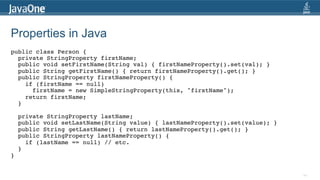










![Layout in GroovyFX
gridPane(hgap: 5, vgap: 10, padding: 25) {!
columnConstraints(minWidth: 50, halignment: "right")!
columnConstraints(prefWidth: 250)!
label("Send Us Your Feedback", font: "24pt sanserif", !
row: 0, columnSpan: GridPane.REMAINING, halignment: "center",!
margin: [0, 0, 10])!
!
label("Name: ", row: 1, column: 0)!
textField(promptText: "Your name", row: 1, column: 1, hgrow: 'always')!
!
label("Email:", row: 2, column: 0)!
textField(promptText: "Your email", row: 2, column: 1, hgrow: 'always')!
!
label("Message:", row: 3, column: 0, valignment: "baseline")!
textArea(row: 3, column: 1, hgrow: "always", vgrow: "always")!
!
button("Send Message", row: 4, column: 1, halignment: "right")!
}!
55](https://image.slidesharecdn.com/hackingjavafxwithgroovyclojurescalaandvisage-120719084046-phpapp01/85/Hacking-JavaFX-with-Groovy-Clojure-Scala-and-Visage-Stephen-Chin-55-320.jpg)

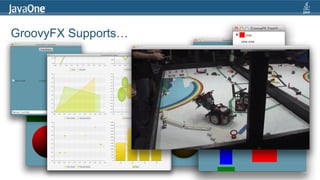


![A Little About Clojure
> Started in 2007 by Rich Hickey
> Functional Programming Language
> Derived from LISP
> Optimized for High Concurrency
(def hello (fn [] "Hello world"))
(hello)
> … and looks nothing like Java!
60](https://image.slidesharecdn.com/hackingjavafxwithgroovyclojurescalaandvisage-120719084046-phpapp01/85/Hacking-JavaFX-with-Groovy-Clojure-Scala-and-Visage-Stephen-Chin-60-320.jpg)
![Clojure Syntax in One Slide
Symbols Collections
(commas optional)
> numbers – 2.178 > Lists
> ratios – 355/113 (1, 2, 3, 4, 5)
> strings – “clojure”, “rocks” > Vectors
> characters – a b c d [1, 2, 3, 4, 5]
> symbols – a b c d > Maps
> keywords – :alpha :beta {:a 1, :b 2, :c 3, :d 4}
> boolean – true, false > Sets
> null - nil #{:a :b :c :d :e}
(plus macros that are syntactic sugar wrapping the above)
61](https://image.slidesharecdn.com/hackingjavafxwithgroovyclojurescalaandvisage-120719084046-phpapp01/85/Hacking-JavaFX-with-Groovy-Clojure-Scala-and-Visage-Stephen-Chin-61-320.jpg)
![Clojure GUI Example
(defn
javafxapp
[]
(let
[stage
(Stage.
"JavaFX
Stage")
scene
(Scene.)]
(.setFill
scene
Color/LIGHTGREEN)
(.setWidth
stage
600)
(.setHeight
stage
450)
(.setScene
stage
scene)
(.setVisible
stage
true)))
(javafxapp)
62](https://image.slidesharecdn.com/hackingjavafxwithgroovyclojurescalaandvisage-120719084046-phpapp01/85/Hacking-JavaFX-with-Groovy-Clojure-Scala-and-Visage-Stephen-Chin-62-320.jpg)
![Refined Clojure GUI Example
(defn
javafxapp
[]
(doto
(Stage.
"JavaFX
Stage")
(.setWidth
600)
(.setHeight
450)
(.setScene
(doto
(Scene.)
(.setFill
Color/LIGHTGREEN)
(.setContent
(list
(doto
(Rectangle.)
(.setX
25)
(.setY
40)
(.setWidth
100)
(.setHeight
50)
(.setFill
Color/RED))))))
(.setVisible
true)))
(javafxapp)
63](https://image.slidesharecdn.com/hackingjavafxwithgroovyclojurescalaandvisage-120719084046-phpapp01/85/Hacking-JavaFX-with-Groovy-Clojure-Scala-and-Visage-Stephen-Chin-63-320.jpg)
![Refined Clojure GUI Example
(defn
javafxapp
[]
(doto
(Stage.
"JavaFX
Stage")
(.setWidth
600)
Doto allows nested data
(.setHeight
450)
(.setScene
(doto
(Scene.)
structures
(.setFill
Color/LIGHTGREEN)
(.setContent
(list
(doto
(Rectangle.)
(.setX
25)
(.setY
40)
(.setWidth
100)
(.setHeight
50)
(.setFill
Color/RED))))))
(.setVisible
true)))
(javafxapp)
64](https://image.slidesharecdn.com/hackingjavafxwithgroovyclojurescalaandvisage-120719084046-phpapp01/85/Hacking-JavaFX-with-Groovy-Clojure-Scala-and-Visage-Stephen-Chin-64-320.jpg)
![Closures in Clojure
> Inner classes can be created using proxy
(.addListener
hoverProperty
(proxy
[ChangeListener]
[]
(handle
[p,
o,
v]
(.setFill
rect
(if
(.isHover
rect)
Color/GREEN
Color/RED)))))
65](https://image.slidesharecdn.com/hackingjavafxwithgroovyclojurescalaandvisage-120719084046-phpapp01/85/Hacking-JavaFX-with-Groovy-Clojure-Scala-and-Visage-Stephen-Chin-65-320.jpg)
![Closures in Clojure
> Inner classes can be created using proxy
Proxy form:
(proxy
[class]
[args]
fs+)
f => (name
[params*]
body)
(.addListener
hoverProperty
(proxy
[ChangeListener]
[]
(handle
[p,
o,
v]
(.setFill
rect
(if
(.isHover
rect)
Color/GREEN
Color/RED)))))
66](https://image.slidesharecdn.com/hackingjavafxwithgroovyclojurescalaandvisage-120719084046-phpapp01/85/Hacking-JavaFX-with-Groovy-Clojure-Scala-and-Visage-Stephen-Chin-66-320.jpg)

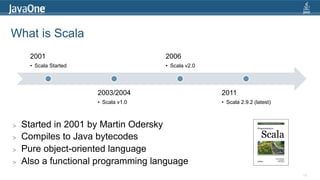

![Java vs. Scala DSL
public
class
VanishingCircles
extends
Application
{
object
VanishingCircles
extends
JFXApp
{
var
circles:
Seq[Circle]
=
null
public
static
void
main(String[]
args)
{
stage
=
new
Stage
{
Application.launch(args);
title
=
"Vanishing
Circles"
}
width
=
800
height
=
600
@Override
scene
=
new
Scene
{
public
void
start(Stage
primaryStage)
{
fill
=
BLACK
primaryStage.setTitle("Vanishing
Circles");
circles
=
for
(i
<-‐
0
until
50)
yield
new
Circle
{
Group
root
=
new
Group();
centerX
=
random
*
800
Scene
scene
=
new
Scene(root,
800,
600,
Color.BLACK);
centerY
=
random
*
600
List<Circle>
circles
=
new
ArrayList<Circle>();
radius
=
150
for
(int
i
=
0;
i
<
50;
i++)
{
fill
=
color(random,
random,
random,
.2)
40 Lines 33 Lines
final
Circle
circle
=
new
Circle(150);
effect
=
new
BoxBlur(10,
10,
3)
circle.setCenterX(Math.random()
*
800);
strokeWidth
<==
when
(hover)
then
4
otherwise
0
circle.setCenterY(Math.random()
*
600);
stroke
=
WHITE
circle.setFill(new
Color(Math.random(),
Math.random(),
Math.random(),
.2));
onMouseClicked
=
{
circle.setEffect(new
BoxBlur(10,
10,
3));
Timeline(at
(3
s)
{radius
-‐>
0}).play()
1299 Characters
circle.addEventHandler(MouseEvent.MOUSE_CLICKED,
new
EventHandler<MouseEvent>()
{
public
void
handle(MouseEvent
t)
{
KeyValue
collapse
=
new
KeyValue(circle.radiusProperty(),
0);
new
Timeline(new
KeyFrame(Duration.seconds(3),
collapse)).play();
}
591 Characters
}
content
=
circles
}
}
}
});
circle.setStroke(Color.WHITE);
new
Timeline
{
circle.strokeWidthProperty().bind(Bindings.when(circle.hoverProperty())
cycleCount
=
INDEFINITE
.then(4)
autoReverse
=
true
.otherwise(0));
keyFrames
=
for
(circle
<-‐
circles)
yield
at
(40
s)
{
circles.add(circle);
Set(
}
circle.centerX
-‐>
random
*
stage.width,
root.getChildren().addAll(circles);
circle.centerY
-‐>
random
*
stage.height
primaryStage.setScene(scene);
)
primaryStage.show();
}
}.play();
Timeline
moveCircles
=
new
Timeline();
}
for
(Circle
circle
:
circles)
{
KeyValue
moveX
=
new
KeyValue(circle.centerXProperty(),
Math.random()
*
800);
KeyValue
moveY
=
new
KeyValue(circle.centerYProperty(),
Math.random()
*
600);
moveCircles.getKeyFrames().add(new
KeyFrame(Duration.seconds(40),
moveX,
moveY));
}
moveCircles.play();
}
}
70](https://image.slidesharecdn.com/hackingjavafxwithgroovyclojurescalaandvisage-120719084046-phpapp01/85/Hacking-JavaFX-with-Groovy-Clojure-Scala-and-Visage-Stephen-Chin-70-320.jpg)

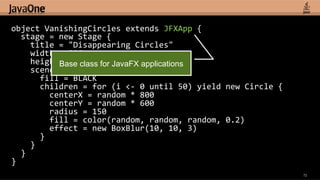

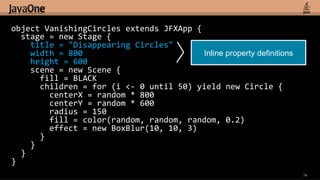




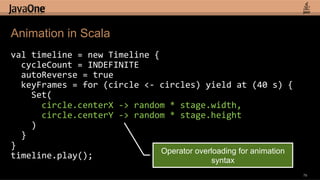
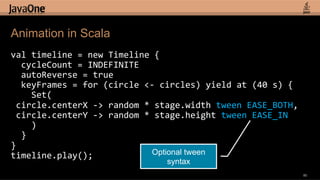



 {!
columns = Seq(!
new TableColumn[Speaker, String] {!
text: "Name"!
converter = {_.firstName}!
} new TableColumn[Speaker, String] {!
text: "Age"!
converter = {_.age}!
}!
new TableColumn[Speaker, String] {!
text: "Gender"!
converter = {_.gender}!
}!
new TableColumn[Speaker, String] {!
text: "Birth"!
converter = {dateFormat.format(_.dob)}, !
}!
)}! 84](https://image.slidesharecdn.com/hackingjavafxwithgroovyclojurescalaandvisage-120719084046-phpapp01/85/Hacking-JavaFX-with-Groovy-Clojure-Scala-and-Visage-Stephen-Chin-84-320.jpg)

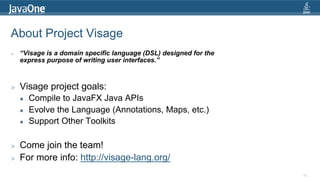
![Java vs. Visage DSL
public
class
VanishingCircles
extends
Application
{
var
circles:Circle[];
Stage
{
public
static
void
main(String[]
args)
{
title:
"Vanishing
Circles"
Application.launch(args);
Scene
{
}
width:
800
height:
600
@Override
fill:
BLACK
public
void
start(Stage
primaryStage)
{
Group
{
primaryStage.setTitle("Vanishing
Circles");
circles
=
for
(i
in
[1..50])
{
Group
root
=
new
Group();
def
c:Circle
=
Circle
{
Scene
scene
=
new
Scene(root,
800,
600,
Color.BLACK);
centerX:
random()
*
800
List<Circle>
circles
=
new
ArrayList<Circle>();
centerY:
random()
*
600
for
(int
i
=
0;
i
<
50;
i++)
{
radius:
150
40 Lines 35 Lines
final
Circle
circle
=
new
Circle(150);
fill:
color(random(),
random(),
random(),
.2)
circle.setCenterX(Math.random()
*
800);
effect:
BoxBlur
{
circle.setCenterY(Math.random()
*
600);
height:
10
circle.setFill(new
Color(Math.random(),
Math.random(),
Math.random(),
.2));
width:
10
circle.setEffect(new
BoxBlur(10,
10,
3));
iterations:
3
1299 Characters
circle.addEventHandler(MouseEvent.MOUSE_CLICKED,
new
EventHandler<MouseEvent>()
{
public
void
handle(MouseEvent
t)
{
KeyValue
collapse
=
new
KeyValue(circle.radiusProperty(),
0);
new
Timeline(new
KeyFrame(Duration.seconds(3),
collapse)).play();
487 Characters
}
stroke:
WHITE
strokeWidth:
bind
if
(c.hover)
5
else
0
onMouseClicked:
function(e)
{
}
Timeline
{at
(3s)
{c.radius
=>
0}}.play()
});
}
circle.setStroke(Color.WHITE);
}
circle.strokeWidthProperty().bind(Bindings.when(circle.hoverProperty())
}
.then(4)
}
.otherwise(0));
}
circles.add(circle);
}
}
root.getChildren().addAll(circles);
Timeline
{
primaryStage.setScene(scene);
for
(circle
in
circles)
at
(40s)
{
primaryStage.show();
circle.centerX
=>
random()
*
800;
circle.centerY
=>
random()
*
600
Timeline
moveCircles
=
new
Timeline();
}
for
(Circle
circle
:
circles)
{
}.play()
KeyValue
moveX
=
new
KeyValue(circle.centerXProperty(),
Math.random()
*
800);
KeyValue
moveY
=
new
KeyValue(circle.centerYProperty(),
Math.random()
*
600);
moveCircles.getKeyFrames().add(new
KeyFrame(Duration.seconds(40),
moveX,
moveY));
}
moveCircles.play();
}
}
87](https://image.slidesharecdn.com/hackingjavafxwithgroovyclojurescalaandvisage-120719084046-phpapp01/85/Hacking-JavaFX-with-Groovy-Clojure-Scala-and-Visage-Stephen-Chin-87-320.jpg)
![How about JavaFX on… Visage
Stage
{
title:
"Vanishing
Circles"
scene:
Scene
{
width:
800
height:
600
fill:
BLACK
content:
Group
{
circles
=
for
(i
in
[1..50])
{
Circle
{
centerX:
random()
*
800
centerY:
random()
*
600
}
}
}
}
}
88](https://image.slidesharecdn.com/hackingjavafxwithgroovyclojurescalaandvisage-120719084046-phpapp01/85/Hacking-JavaFX-with-Groovy-Clojure-Scala-and-Visage-Stephen-Chin-88-320.jpg)
![How about JavaFX on… Visage
Stage
{
title:
"Vanishing
Circles"
scene:
Scene
{
width:
800
height:
600
fill:
BLACK
content:
Group
{
circles
=
for
(i
in
[1..50])
{
Circle
{
centerX:
random()
*
800
centerY:
random()
*
600
}
}
}
}
}
89](https://image.slidesharecdn.com/hackingjavafxwithgroovyclojurescalaandvisage-120719084046-phpapp01/85/Hacking-JavaFX-with-Groovy-Clojure-Scala-and-Visage-Stephen-Chin-89-320.jpg)
![How about JavaFX on… Visage
Stage
{
title:
"Vanishing
Circles"
Scene
{
width:
800
height:
600
fill:
BLACK
Group
{
circles
=
for
(i
in
[1..50])
{
Circle
{
centerX:
random()
*
800
centerY:
random()
*
600
}
}
}
}
}
90](https://image.slidesharecdn.com/hackingjavafxwithgroovyclojurescalaandvisage-120719084046-phpapp01/85/Hacking-JavaFX-with-Groovy-Clojure-Scala-and-Visage-Stephen-Chin-90-320.jpg)
![Visage is JavaFX Script++
> Default Parameters
> New Literal Syntax For:
l Angles – 35deg,
4rad,
1turn
l Colors – #DDCCBB,
#AA33AA|CC
l Lengths – 5px,
2pt,
3in,
4sp
> Null-check Dereference
l var width = rect.!width
> Built-in Bindable Maps (coming soon!)
l var fruitMap = ["red" : apple, "yellow" : banana]
l var fruit = bind fruitMap["red"]
91](https://image.slidesharecdn.com/hackingjavafxwithgroovyclojurescalaandvisage-120719084046-phpapp01/85/Hacking-JavaFX-with-Groovy-Clojure-Scala-and-Visage-Stephen-Chin-91-320.jpg)



